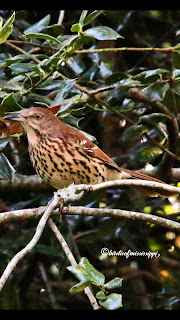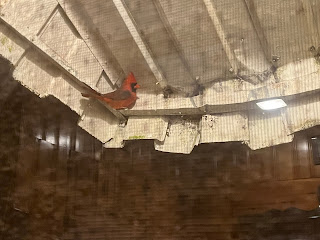DON’T CHOP THAT TREE - 1/31/20
DON’T CHOP THAT TREE
By PEGGY WILLIAMS AKA Birdie of Mississippi
Many times when we see trees with dead limbs, we automatically think that we should get to chopping, but by doing this we are actually hurting our bird population. Woodpeckers, Northern Flickers and Sapsuckers feed off bugs that inhabit dead or dying limbs. Bugs, of course, are a great food source for birds and by birds feeding on bugs and larvae, they help keep bugs under control and in turn, keeps our ecosystem healthy. “So leave dead trees and snags up in your yard and garden, as long as possible until personal or property safety becomes a concern” says The Gardener’s Bird Book by Tom Carpenter a National Home Gardening Club book.
This is the time of year that you will begin to hear a lot of hammering or pecking on wood or metal by woodpeckers. Generally there are three reasons for this hammering. The number one reason is that the woodpeckers are foraging for food; the second reason is that the male woodpeckers are searching for a mate; and third is that after finding a mate, the male will begin to excavate a hole for a place for the couple to build a nest and start their family.
In this area of the South there are several types of woodpeckers that frequent our yards. There is a very small woodpecker called a Downy that is black and white that is only about 6” inches long that eats often in my backyard. The male Downy has a bright red spot at the back of his head that makes him easy to spot. He has a “look-alike” woodpecker called “Hairy” that could almost be his twin if you go by his colors and markings, but a Hairy is about 3” longer than the Downy. Some other differences are that the Hairy likes to live out in the woods, but the Downy will more likely be found at your backyard feeders. The Hairy has a barbed tongue and a bill that is twice as long as the Downy which enables him to reach deeper into a tree to reach bugs than the Downy. But if you hang suet feeders up you might see both the Hairy and Downy getting an energy boost.
There are other interesting woodpeckers that stay year round in our area – The Red-Bellied Woodpecker, Red-Headed Woodpecker, Yellow-Bellied Sapsucker, Pileated Woodpecker, and the Northern Flicker. They each have distinctive looks, calls, beak sizes and foods that they enjoy. The Red-Headed Woodpecker seldom drills trees for insects, but prefer to snag insects flying by them. The Northern Flicker prefers to feed on the ground instead of up in the trees. He is the “anteater” of the bird world having a diet that consists mostly of ants, but also enjoys beetles, caterpillars, crickets, grasshoppers, insect larvae and also fruits and berries.
As I listed all the insects that birds eat I became once again thankful for birds and the job that they fulfill on insect control. It is sad to read that birds are dying off because we use so many insect pesticides and we need more pesticides because there are not enough birds to eat up all the insects….something is very wrong with this picture. We are stewards of God’s earth and oh how we seem to mess it up! As I “Look at the birds of the air” Matthew 6:26, I see their purpose and our need for them on this planet. We must take care of them and all creatures large and small. My photos may be viewed & “LIKED” on Facebook, Instagram and Pinterest - “Birdie of Mississippi”. E-mail: birdieofmississippi@gmail.com - Read my Blog @ http://www.birdieofmississippi.blogspot.com




Comments
Post a Comment